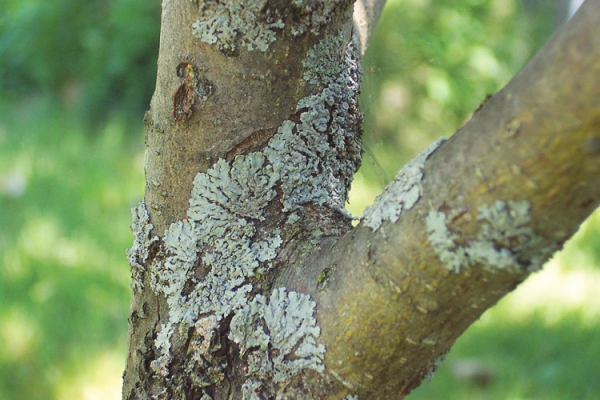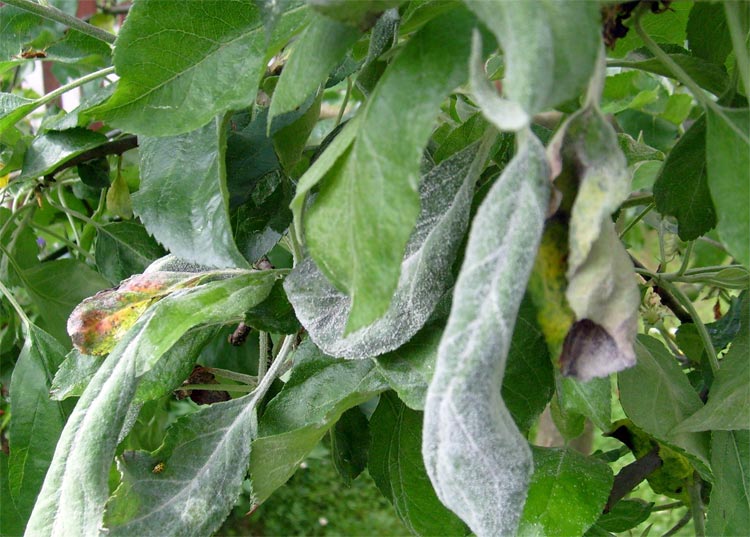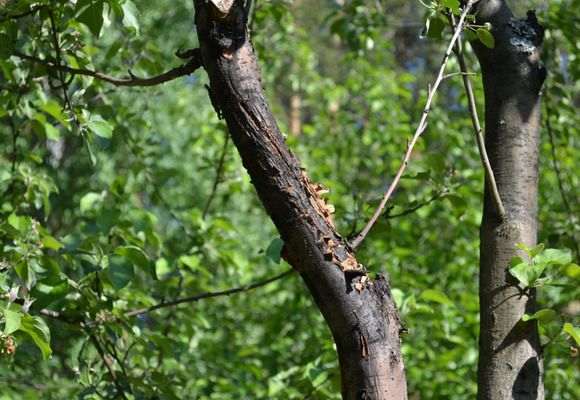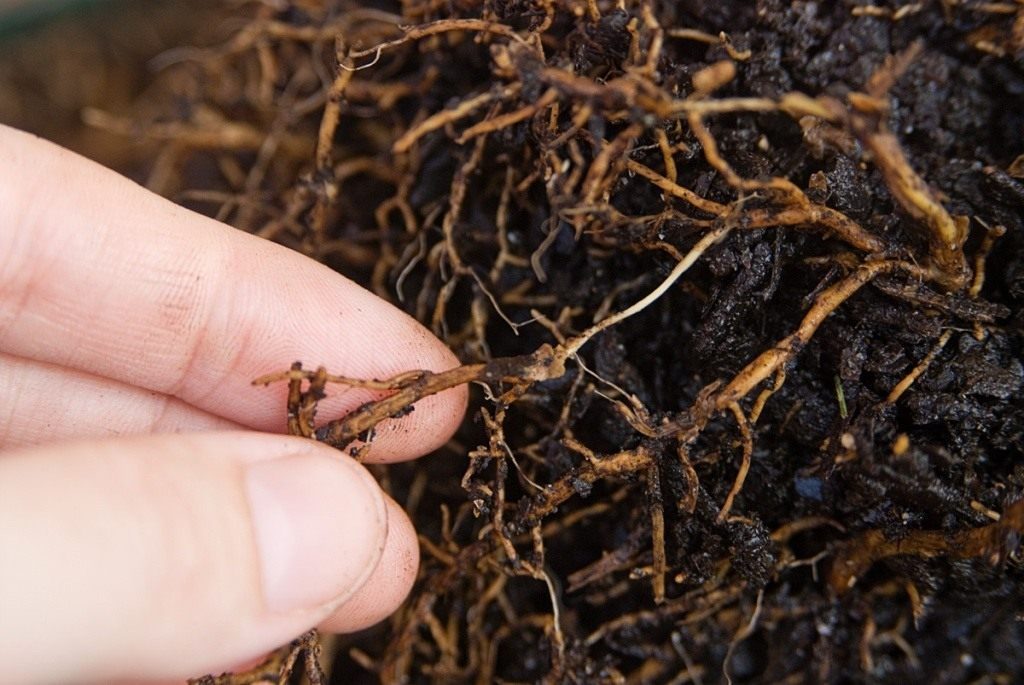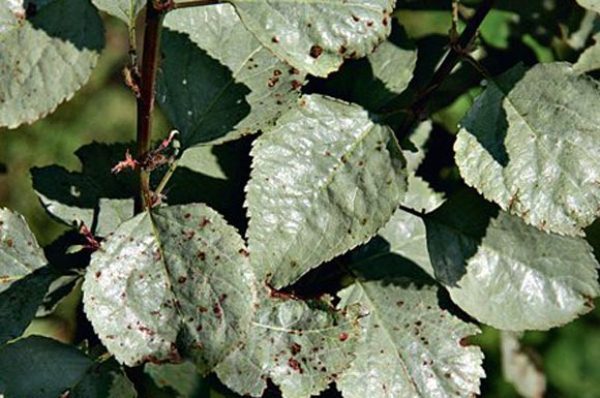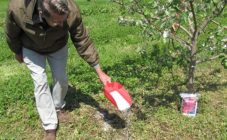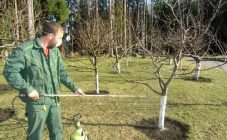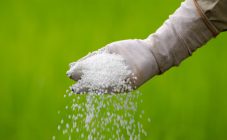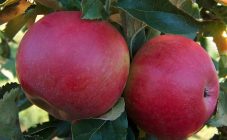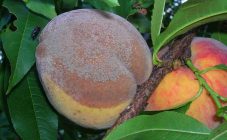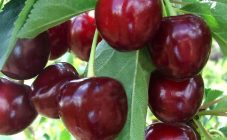Content:
Apple trees can be subject to various diseases, some can destroy not only the crop, but also the tree itself. The earlier treatment is started, the greater the chances of success.
Diseases of apple trees
Diseases of apple trees can be divided into several groups:
- Fungal. Outwardly, fungal diseases of apple trees can look like moss, lichen, flour, a change in the color of the leaves (from green to silver). Mushrooms retain moisture in the bark surfaces, which leads to weakening of the tree and the appearance of insects in the formed layers. Diseases develop quite quickly (in 2-3 months) and in 3-4 years they can destroy the tree.
- Bacterial. Such diseases can be recognized by leaf deformation, blackening or drying. The bacteria damage the tree, making it vulnerable to any infection. Diseases develop rapidly, literally in one month, are dangerous in that they can weaken a tree that will not survive the winter cold in the future.
- Viral. Harmful viruses leave spots on the leaves, provoke them to fall off, make the branches soft and weak. The fruits also suffer - they crack, overgrow with crusts and growths. They develop in 2-3 months.
- Impact effect. Not only diseases, but also pests threaten the apple tree. Parasites, insects are often the cause of the disease. On the trunk of a tree, on the foliage, a specific plaque is formed due to the vital activity of pests. The parasites eat foliage and fruits. Many insects tolerate winter well and increase their numbers every year.
- Due to the lack of certain substances... Due to the lack of trace elements, the leaves turn yellow ahead of time, change color, fall off, the shoots die off. Plant growth slows down, shoots bush, fruits are poorly tied.
Description of the most dangerous diseases of apple trees
Common cancer
It belongs to the fungal type of disease, caused by the fungus Neonectria galligena. It all starts with the appearance of large brown spots, which crack over time. Further, an ulcer forms on the trunk, which increases all the time. Slugs are formed on the branches, which subsequently grow together, forming a gap. The leaves are covered with brown spots, dry up, fall off. Brown spots also appear on fruits. The wood dies, the tree dies in 2-4 years.
Most often, cancer affects the trunks in the places of frostbites and where there is mechanical damage. Diseased branches and trunks are cut and burned. Small ulcers are treated with copper sulfate (3% solution), after which they are coated with oil paint, which should contain linseed oil. As a preventive measure, it is necessary to spray the plants with Bordeaux mixture annually and carefully monitor the quality of the planting material.
Black cancer
Fungal disease. It is provoked by the mushroom Sphaeropsis malorum Berck. It all starts with the formation of red or brown spots in the forks of the tree, which then darken. The black bark becomes very dry, cracks, flakes off the trunk and falls off in large chunks. Fruits and leaves are covered with maroon spots. It also happens that many cracks form on the bark, the bark does not change color, but it crumbles very easily. The affected areas must be immediately cut out and destroyed, because the disease can quickly infect neighboring fruit trees, including pears. Prevention - Bordeaux mixture every year in the form of spraying, analogs such as Abiga-Peak, HOM are also suitable.
Scab
The fungal disease is provoked by the fungus Venturia inaegualis Wint. It all starts with the fact that unusual spots are formed on the leaves, velvety to the touch, brown in color. Subsequently, the leaves turn yellow very quickly and fall off early. Apples crack because their skin becomes inelastic. Spores of the fungus can infect ovaries and shoots, small specks appear on apples.
The likelihood of a fungus infection is higher when there is a lot of rainfall in summer and spring. Scab damages only apple trees. Branches, fruits and leaves infected with scab must be removed and burned. Treatment is carried out with Topaz (2ml per 10l) or HOM (4g per 10l) - the trunk is treated before and after flowering.
Powdery mildew
The fungus Podosphaera leucotricha Salm is the causative agent of this disease, which markedly decreases yields (by about 40%). Young leaves in early spring begin to become covered with light spots with a gray tint. The spores also droop into shoots, which after a short time change shape or stop growing.
The leaves begin to dry and curl. Infected buds do not form fruit. And if the fruit is already formed and affected, a plaque resembling rust forms on it.
Not only apple trees, but also other fruit plants are exposed to disease, but not to the same extent, but weaker. If powdery mildew is seen on trees, all diseased branches, fruits, leaves should be removed immediately and the apple trees should be treated with a fungicide containing copper. During the summer period, pollination of trees with colloidal sulfur no more than 3 times will help to cope with the disease. Colloidal sulfur is sold in the store and diluted according to the instructions.
You can also try solutions using potassium permanganate, soda ash and soap and ready-made preparations Topaz, Skor.
Cytosporosis
It is a fungal disease. Called by the fungus Cytospora schulzeri Sacc. et Syd. The branches acquire a brown color, cystosporous tubercles of brown and gray shades appear on the bark, which then swell and acquire the shape of a blunt cone. The bark and branches become bumpy and dry, resembling a washcloth. Cytosporosis of the apple tree threatens those trees that grow in a densely planted garden, in which crowns are too often pruned. Trees weakened by mechanical damage, sunburn and winter frost are at risk of disease. As a preventive measure, Bordeaux mixture is suitable (spraying once a year). As a rule, extensive cytosporosis of the apple tree cannot be treated. The damaged areas of the tree are cut and burned.
Tuberculariosis
Fungal disease. The causative agent is the mushroom Tubercularia vulgaris Tode. Threatens with the death of the bark.
In spring, shoots and leaves begin to turn brown and dry quickly. Small spores with a diameter of 2 mm are formed on the bark, resembling red pads. Over time, the spores darken and dry up. The inner part of the bark near the trunk and branches quickly dies off, and shoots suffer with it.
If the trunk of an apple tree is damaged, most likely, it will not be possible to save the tree, since the infection lives in the bark. Damaged branches can be cut down and burned. Bordeaux mixture is also used for the prevention of tuberculariosis.
Grebenshik
Refers to fungal diseases. Called by the fungus Schyzophyllum commune Fr. Weak and frozen trees, shrubs, fruit and deciduous species are at risk of disease. It all starts with the formations of small bodies that resemble hats. These hats are light gray in color and feel like leather. There are many of them and they quickly spread through the tree. Mushrooms provoke drying of the tree and rotting of the trunk.
In advanced cases, with extensive damage, it remains only to cut down and burn the apple tree.With minor lesions, you can cut down the diseased part, clean wood, remove branches. After cutting down, it is necessary to process the cuts with a solution of copper sulfate (1%), cover them with oil paint on drying oil. In the spring, before the leaves bloom, you need to treat the trees with Bordeaux mixture or analogues.
Root rot
The fungus Armillaria mellea provokes rotting of the tree; it lives in the roots or on stumps. First, the lower part of the bark is affected, then the fungus under the bark forms rhizomorphs - a plexus of mushroom threads. Thanks to the mushroom threads, fruiting bodies are formed that resemble brown and yellow caps.
This mushroom is very tenacious - its spores persist in the ground, root system and wood. This disease is also called peripheral rot, because of it the bark and trunk die off. Unmistakably, the disease can be identified by annular spots with a brown coating, which are located throughout the trunk. Prevention of root rot - the use of Bordeaux mixture. Diseased branches and trees are immediately cut down and burned. If root rot is found, it is imperative to treat the soil near the apple tree with a preparation containing copper. Fungicides such as copper oxychloride, copper sulfate, cuprosil, cuproxate are suitable. With a solution containing copper, you need to shed the soil well.
Moniliosis
Also called fruit rot and disease of young apple trees. It affects most often young trees that do not yet have a thick bark. Moniliosis of the apple tree is caused by such fungi as:
- M. fructigena Pers - apples rot directly.
- and Monilia cinerea Bon. f. mali Worm - affects ovaries, fruit branches, flowers and leaves, on which a burn forms.
Spores of fungi spread to neighboring plants with the help of wind, rain, insects. Affected fruits turn black and dry and are a powerful source of infection. Fruit rot of an apple tree involves the following control measures: immediate collection and destruction of diseased fruits, branches, leaves outside the garden, pruning of dried branches. For the prevention of monilial ailment, it is advised to use a solution of nitrafen emulsion - 200 g is enough for 10 liters of water. Colloidal sulfur and DNOC are both suitable.
Chlorosis
It develops due to an acute lack of nutrients in young leaves: iron, nitrogen, magnesium. At first, the leaves turn yellow evenly, in more severe cases the foliage turns brown and dries up, and the branches and trunk die off. The reason for the lack of important substances can be severe frosts, which negatively affected apple trees, the spread of hidden rot, viruses, an increased level of alkali in the soil, and waterlogging. How to treat an apple tree then? - The best way to fix the problem is to establish the cause in time.
Bacterial burn
Infection with gram-negative bacteria causes the entire tree to turn black. The foliage turns black and dries up from top to bottom, and after it the trunk. Apples darken and stop growing. It is necessary to immediately cut off the dried branches with a sterile clean disinfected instrument.
Alternaria
Mushrooms of the class Ascomycetes are the causative agents of the disease. Apple Alternaria damages fruits and leaves. In late spring and early summer, brown spots with a purple border appear on the leaves, they grow and merge into one large spot. Apples lose their flavor, and some die off and fall off the branch. Suspicious fruits and bad leaves are harvested on time, the apple tree is fertilized with Immunotocyte, Immunocytophyte in accordance with the instructions. In the fall, they deeply dig the soil around the tree, add a solution of copper sulfate.
Milky shine
The causative agent is a basidiomycete fungus. The color of the leaves changes, becomes milky gray, with a shiny tint. The crop crumbles, branches and shoots die off. Improper care leads to the appearance of this disease, namely: excessive watering, shaded areas, lack of fertilizers.
Rust
The fungus Gymnosporangium tremelloides Hartig is the causative agent of this disease. Mostly leaves are affected, less often fruits and shoots. On the upper side of the leaves, rust-like spots appear, red-orange, with small black dots in the middle. In advanced cases, all the leaves on the tree turn yellow ahead of time and fall off. Brown spots form on the underside of the leaves. The fungus tolerates winter well, it usually affects the juniper, but it also likes the apple tree. If the mushroom has already overwintered in the apple tree, growths containing brownish mucus will appear in the cracks in the bark in spring. For the prevention and treatment of rust, copper sulfate, HOM or Abiga-peak are used before and after flowering.
What to do if the apple tree is sick
In order for the apple orchard to please and bear fruit every year, it is necessary to regularly take care of the trees, carefully examine them for diseases. It is necessary to plant young plants where there is a lot of sun and space. Fallen leaves should always be removed in autumn, because they probably contain some kind of infection. When buds begin to bloom, apple trees are treated with Agat-25K, which increases the resistance of trees to various pathogens, activates plant growth.
Whitewashing trees with ordinary lime can reliably protect apple trees from pests and prevent various diseases of apples.
